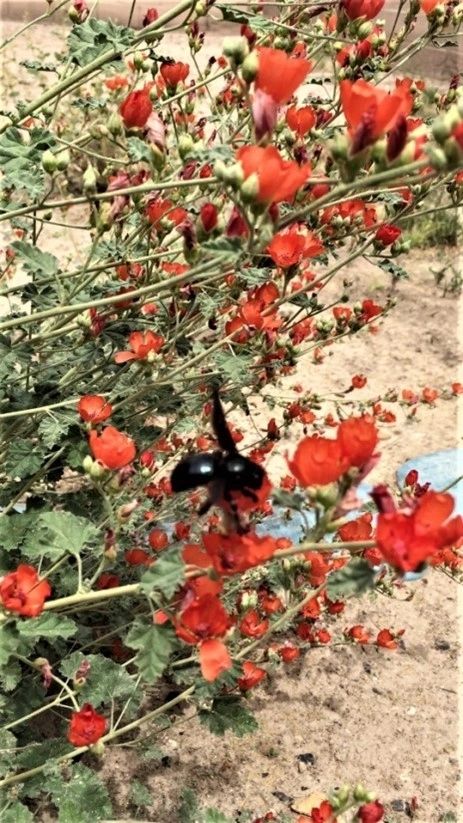The Globe Mallow

HOLLYHOCKS IN THE DESERT? WELL, A RELATIVE!
Beautiful to see… what a show! From March to April the deep red-orange to apricot-colored flowers of the globe mallow (Sphaeralcea ambigua) stand out like bright flames along trails and on slopes in the drier parts of Clark County Wetlands Park. Should summer rains prevail, the plant can continue blooming throughout the summer and into the fall, though the best displays are always in spring.
Globe mallow is a non-woody perennial that loves disturbed soil. It is one of the first plants to return to the sides of roads and trails after construction or maintenance. With its little, hollyhock-like flowers and wrinkled, blunt-palmate leaves, it looks like a roadside geranium. Mature plants have a rounded shape and may grow up to three feet tall.
Globe mallow provides cover and food for a variety of creatures from small to large. Monarch-like painted lady butterflies (Vanessa cardui) drink its nectar and their caterpillars feed and shelter among its leaves. Many species of moths and butterflies, including skippers and emeralds, also partake of its nectar.
Numerous native bees, including the large, shiny black California carpenter bee (Xylocopa californica, see photo), visit globe mallow for both its nectar and pollen. The plant’s namesake, a solitary native burrowing bee called the globe mallow bee (Diadasia diminuta), feeds and raises its offspring exclusively on nectar and pollen from the plant.
Additionally, hummingbirds delicately hover Globe Mallow flowers to sip nectar. Desert tortoises and bighorn sheep browse the plant’s leaves, stems, and flowers.
Globe mallow makes a handsome landscape plant, too. It is water-thrifty, grows easily from seed, and is easy to purchase from garden suppliers. In the yard, all it needs a heavy pruning once a year to prevent it from becoming too “leggy” and to keep its rounded shape.
Like most desert plants, globe mallow is not defenseless. When working near these plants, watch out for the star-shaped hairs that cover the leaves as they can irritate the skin. And, if they happen to get into your eyes, you will quickly find out why the plant has another common name: “sore-eye poppy!”
– By Chris Leavitt, President; photo also by Chris Leavitt
Please enjoy these YouTube videos!
Globe Mallow Flowers
Globe Mallow Bee
Carpenter Bees
